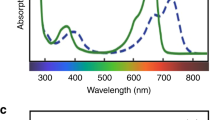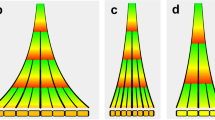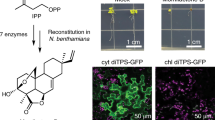Abstract
Some animal and yeast hormone genes produce prohormone polypeptides that are proteolytically processed to produce multiple copies of hormones with the same or different functions1. In plants, four polypeptides have been identified that can be classed as hormones2,3,4,5 (intercellular chemical messengers6) but none are known to be produced as multiple copies from a single precursor. Here we describe a polyprotein hormone precursor, present in tobacco plants, that gives rise to two polypeptide hormones, as often found in animals and yeast. The tobacco polypeptides activate the synthesis of defensive proteinase-inhibitor proteins in a manner similar to that of systemin, an 18-amino-acid polypeptide found in tomato plants2. The two tobacco polypeptides are derived from each end of a 165-amino-acid precursor that bears no homology to tomato prosystemin. The data show that structurally diverse polypeptide hormones in different plant species can serve similar signalling roles, a condition not found in animals or yeast.
This is a preview of subscription content, access via your institution
Access options
Subscribe to this journal
Receive 51 print issues and online access
$199.00 per year
only $3.90 per issue
Buy this article
- Purchase on Springer Link
- Instant access to full article PDF
Prices may be subject to local taxes which are calculated during checkout




Similar content being viewed by others
References
Niall, H. D. The evolution of peptide hormones. Ann. Rev. Physiol. 44, 615– 624 (1982).
Pearce, G., Strydom, D., Johnson, S. & Ryan, C. A. A polypeptide from tomato leaves induces wound-inducible proteinase inhibitor proteins. Science 253, 895– 897 (1991).
Matsubayashi, Y. & Sakagami, Y. Phytosulfokine, sulfated peptides that induce the proliferation of single mesophyll cells of Asparagus officinalis L. Proc. Natl Acad. Sci. USA 93, 7623– 7627 (1996).
Fletcher, J. C., Brandu, U., Running, M. P., Simon, R. & Meyerowitz, E. M. Signaling of cell fate decisions by CLAVATA3 in Arabidopsis shoot meristems. Science 283, 1911– 1914 (1999).
Schopfer, C. R., Nasrallah, M. E. & Nasrallah, J. B. The male determinant of self-incompatibility in Brassica. Science 286, 1697– 1700 (1999).
Voet, D. & Voet, J. G. Biochemistry 2nd edn 1261 (Wiley and Sons, New York, 1995).
Constabel, C. P., Yip, L. & Ryan, C. A. Prosystemin from potato, black nightshade, and bell pepper: primary structures and biological activities of the predicted systemins. Plant Mol. Biol. 26, 55– 62 (1998).
Pearce, G., Johnson, S. & Ryan, C. A. Purification and characterization from tobacco (Nicotiana tabacum) leaves of six small, wound-inducible, proteinase isoinhibitors of the potato inhibitor II family. Plant Physiol. 102, 639– 644 (1993).
Karban, R. & Baldwin, I. T. Induced Responses to Herbivory (Univ. Chicago Press, Chicago, 1997).
Meindl, T., Boller, T. & Felix, G. The plant wound hormone systemin binds with the N-terminal part to its receptor but needs the C-terminal part to activate it. Plant Cell 10, 1561– 1570 (1998).
Schaller, A. & Oecking, C. Modulation of plasma membrane H+-ATPase activity differentially activates wound and pathogen defense responses in tomato plants. Plant Cell 11, 263– 272 (1999).
Bryant, J., Green, T., Gurusaddaiah, T. & Ryan, C. A. Proteinase inhibitor II from potatoes: isolation and characterization of its protomer components. Biochemistry 15, 3418– 3424 (1976).
Ryan, C. A. The systemin signaling pathway: differential activation of plant defensive genes. Biochim. Biophys. Acta 1477, 112– 121 (2000).
McGurl, B., Pearce, G., Orozco-Cardenas, M. & Ryan, C. A. Structure, expression and antisense inhibition of the systemin precursor gene. Science 255, 1570– 1573 (1992).
Sommer-Knudsen, J., Bacic, A. & Clarke, A. E. Hydroxyproline-rich plant glycoproteins. Phytochemistry 47, 483– 497 (1998).
Ferriss, P. J. et al. Glycosylated polyproline II rods with kinks as a structural motif in plant hydroxyproline-rich glycoproteins. Biochemistry 40, 2978– 2987 (2001).
Stratmann, J. W. & Ryan, C. A. Myelin basic protein kinase activity in tomato leaves is induced systemically by wounding and increases in response to systemin and oligosaccharide elicitors. Proc. Natl Acad. Sci. USA 94, 11085– 11089 (1997).
Scheer, J. M. & Ryan, C. A. A 160 kDa systemin receptor on the surface of Lycopersicon peruvanium suspension-cultured cells. Plant Cell 11, 1525– 1535 (1999).
Matsubayashi, Y. & Sakagami, Y. 120- and 160-kDa receptors for endogenous mitogenic peptide, phyosulfokine-α, in rice plasma membranes. J. Biol. Chem. 275, 15520– 15525 (2000).
Trotochaud, A. E., Hao, T., Wu, G., Yang, Z. & Clark, S. E. The CLAVATA1 receptor-like kinase requires CLAVATA3 for its assembly into a signaling complex that includes KAPP and a Rho-related protein. Plant Cell 11, 393– 405 (1999).
Stein, J. C., Howlett, B., Boyes, D. C., Nasrallah, M. E. & Nasrallah, J. B. Molecular cloning of a putative receptor protein kinase gene encoded at the self-incompatibility locus of Brassica oleraceae. Proc. Natl Acad. Sci. USA 88, 8816– 8820 (1991).
Dombrowski, J. E., Gomez, L., Chrispeels, M. & Raikel, N. V. in Plant Molecular Biology Manual (eds Gelvin, S. B. & Schilperoort, R. A.) J3, 1– 29 (Kluwer Academic, Dordrecht, 1994).
Patterson, D. H., Tarr, G. E., Regnier, F. E. & Martin, S. A. C-terminal ladder sequencing via matrix-assisted laser desorption mass spectrometry coupled with carboxypeptidase Y time-dependent and concentration-dependent digestions. Anal. Chem. 67, 3971– 3978 (1995).
Acknowledgements
This research was supported by the College of Agriculture and Home Economics and by the National Science Foundation. We thank S. Vogtman for growing plants; G. Munske for amino-acid sequence analyses; and W. Siems for MALDI mass spectroscopic analyses.
Author information
Authors and Affiliations
Corresponding author
Supplementary information
Supplement 1.
(DOC 23 KB) Protocol for the purification of tobacco systemins

Supplement 2.
(JPG 17 KB)
Alkalinization of the medium of suspension cultured tobacco cells in response to increasing concentrations of the ‘crude polypeptide extract’ from leaves as described in the Methods
Supplement 3.
(PPT 378 KB)
The changes in molecular masses of Tob Sys I and II during the hydrolysis of 100 pmoles of each in 100 mL 1% trifluoroacetic acid at 80 °C. At the intervals shown, 10 μL aliquots were removed for MALDI-MS analysis. A ladder of fragments duffering by 132 mass units (indicative of pentoses) were produced as the carbohydrate moieties were removed from the polypeptides. a. 0 min. b. 15 min. c. 30 min d. 60 min. e. 180 min.

Supplement 4.
(JPG 38 KB)
Alkalinization assays of synthetic Tob Sys I and II backbone polypeptides using tobacco suspension cultured cells. The change in pH of the culture medium was measured 15 min after addition of the polypeptides. Half maximal activity of each polypeptide is about 2 μM, as compared to 200 pM of the native polypeptides (cf. Figure 2a).

Supplement 5.
(JPG 67 KB)
Alignment of the two deduced tobacco systemin precursor proteins (pro-TobSys-A and pro-TobSys-B). The alignment was made using the Genetics Computer Guoup (GCG-Wisconsin Package Version 10, Madison, WI) programs "translate", "pilieup") (default values) and "prettybox".
Supplement 6.
(PPT 706 KB)
Southern Blots of 5 µg of genomic DNA from tobacco leaves, digested using XbaI SacI NdeI, HindIII, HaeII, EcorRI, and ClaI restriction enzymes. Digested DNA was separted in agarose gels, salt transferred to nylon membranes and probed using Tobacco preproprotein cDNA. Molecular markers anre indicated on the left (Kb). Und=undigested.
Supplement 7.
(PPT 187 KB)
Gel blot analyses of tobacco prosystemin mRNA in leaves of young tobacco plants exposed to either air or air containing methyl jasmonate vapors. Following methyl jasmonate treatment for 6 h, RNA extraction and gel blot analyses were performed as described in Bergey et al (1999).
Rights and permissions
About this article
Cite this article
Pearce, G., Moura, D., Stratmann, J. et al. Production of multiple plant hormones from a single polyprotein precursor. Nature 411, 817–820 (2001). https://doi.org/10.1038/35081107
Received:
Accepted:
Issue Date:
DOI: https://doi.org/10.1038/35081107
This article is cited by
-
Mobile Signaling Peptides: Secret Molecular Messengers with a Mighty Role in Plant Life
Journal of Plant Growth Regulation (2023)
-
Advances and perspectives in discovery and functional analysis of small secreted proteins in plants
Horticulture Research (2021)
-
Phytocytokines function as immunological modulators of plant immunity
Stress Biology (2021)
-
Extracellular DNA: A Relevant Plant Damage-Associated Molecular Pattern (DAMP) for Crop Protection Against Pests—A Review
Journal of Plant Growth Regulation (2021)
-
Production mechanisms, structural features and post-translational modifications of plant peptides
Journal of Plant Biology (2020)
Comments
By submitting a comment you agree to abide by our Terms and Community Guidelines. If you find something abusive or that does not comply with our terms or guidelines please flag it as inappropriate.



